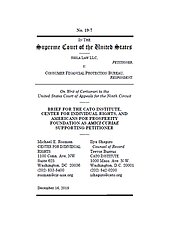Learn more about Cato’s Amicus Briefs Program.
One of the Constitution’s chief protections for liberty is the separation of powers. The legislative power is granted to Congress, the judicial power to the courts, and the executive power to the president. This division cannot be altered by anything short of a constitutional amendment. Still, since the beginning of the 20th century, Congress has enjoyed considerable success in limiting the president’s executive power through the creation of what are known as “independent agencies.” One of the main differences between independent agencies and traditional executive departments is that while officers of the latter serve at the pleasure of the president, the heads of independent agencies are insulated from presidential removal except “for cause.” This structure denies the president the ability to exert control over independent agencies, even though they exercise significant executive power by enforcing laws and pursuing investigations.
In 2010, Congress added another independent agency to the ever-expanding administrative state: the Consumer Financial Protection Bureau. The CFPB is even less accountable to the democratically elected branches because, unlike every independent agency created in the 20th century, all of which are headed by multi-member commissions, the CFPB is headed by a single director, removable only for cause. The CFPB director has near-unilateral authority to enforce 19 federal laws, without answering to anyone. This is a problem.
Supporters of the CFPB’s constitutionality—a group which doesn’t now include the CFPB itself, as the Trump administration has changed sides—seek refuge in a 1935 Supreme Court case called Humphrey’s Executor. In that case, the Court, flying in the face of history and precedent, declared that limitations on the president’s ability to remove the heads of independent agencies were constitutional. Since 1935, the rationale for that decision has become increasingly muddled with subsequent inconsistent cases. The Court has recently shown a willingness to return to enforcing the Constitution’s separation of powers principles, but has lacked an opportunity to address Humphrey’s Executor directly.
Thankfully, the Court now has a case where it can do just that, in a case brought by a law firm that assists in resolving personal-debt issues. The Supreme Court agreed to hear the case of Seila Law v. CFPB, with oral argument scheduled for March 3. Cato has now filed a brief urging the Supreme Court to clarify the constitutional test for removal limitations and find the CFPB unconstitutionally structured. (Cato also filed a brief supporting Seila Law in its request for the Court to hear this case, and has filed twice in the lower courts arguing that the CFPB is unconstitutional.) In our brief, we argue that the best path forward for the Court is to narrow Humphrey’s Executor—or just craft a new “Seila Law” test—so as to allow removal limitations only if the officer in question doesn’t exercise any executive power.
The Supreme Court has an obligation to defend our separation of powers. If the Court allows the CFPB to continue as currently constituted, it will allow major violations of constitutionally protected liberty by a powerful and unaccountable federal agency. If the Court allows removal doctrine to remain muddled and incoherent, it will only lead to more confusion and inconsistency in the lower courts and in Congress. The Court should thus pull the plug on Humphrey’s Executor’s—salvaging its useful parts into a new, more coherent removal doctrine—in the context of finding the CFPB unconstitutional.

This work is licensed under a Creative Commons Attribution-NonCommercial-ShareAlike 4.0 International License.



